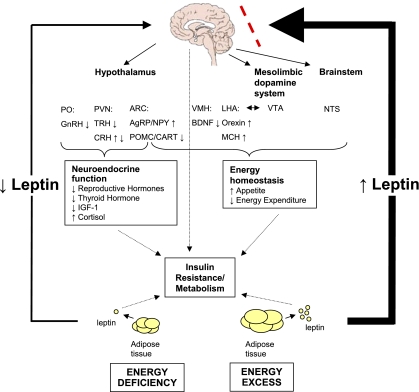Fig. 1.
States of energy excess are associated with hyperleptinemia, but the hypothalamus is resistant or tolerant to the effects of increased leptin (dashed line). Energy deficiency results in hypoleptinemia. As a result, a complex neural circuit comprising orexigenic and anorexigenic signals is activated to increase food intake (220). In response to decreased leptin levels, there is increased expression of orexigenic neuropeptides AgRP and NPY in the ARC (59) and orexin and MCH in the LHA. Furthermore, there is decreased expression of anorexigenic neuropeptides POMC and CART in the ARC (59) and BDNF in the VMH. In addition to neurons that project from the LHA to the VTA, leptin also acts at the VTA of the mesolimbic dopamine system to regulate motivation for and reward of feeding. Leptin activation of the NTS of the brain stem also contributes to satiety. In addition, leptin has direct and/or downstream effects on the PVN and PO that are important for neuroendocrine responses to energy deprivation, including reducing reproductive and thyroid hormones. For the sake of comparison, leptin acts only indirectly on the GnRH-secreting neurons in the hypothalamus, and it can act directly and indirectly on TRH-secreting neurons (220). The effect of leptin on cortisol levels during starvation differs in mice and humans. Unlike in normal mice (102), leptin administration does not reverse the elevated adrenocorticotropin levels associated with starvation in humans (37). The mechanism of leptin's effect on the growth hormone axis is unclear. Dashed arrows indicate how leptin directly and indirectly influences metabolism and insulin resistance. AgRP, agouti-related protein; ARC, arcuate nucleus; BDNF, brain-derived neurotropic factor; CART, cocaine- and amphetamine-regulated transcript; CRH, corticotropin-releasing hormone; GnRH, gonadotropin-releasing hormone; IGF-I, insulin-like growth factor I; LHA, lateral hypothalamic area; MCH, melanin-concentrating hormone; NPY, neuropeptide Y; NTS, nucleus of the solitary tract; PO, preoptic area; POMC, proopiomelanocortin; PVN, paraventricular nucleus; TRH, thyrotropin-releasing hormone; VMH, ventromedial hypothalamic nucleus; VTA, ventral tegmental area.

